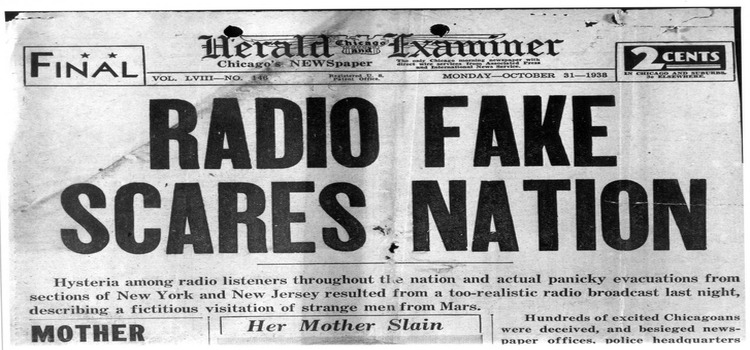On the eve of Halloween in 1938, a young and ambitious American actor and director, Orson Welles, threw the responsibility of mass media into question for a long time with his radio play The War of the Worlds, broadcast on CBS. The program caused an enormous scandal, as thousands fled into the streets in panic, and the incident is still regarded today as the world’s greatest fake-news story.
Fake news that worked too well
The mass panic was triggered by a radio drama based on H. G. Wells’s novel, in which Martians attack Earth. Orson Welles had no intention of deceiving listeners; he simply used a creative approach we might today call an immersive simulation drama. Interrupting the radio’s music program—with terrified pseudo-reporters and realistic sound effects—the play was performed in the style of a news broadcast, prompting people to run for their lives. Those listeners who missed the warning at the beginning, stating that it was a fictional radio play, believed the alien invasion was real. It didn’t help that a popular show on the rival NBC channel ended just as The War of the Worlds was already underway, so many late-arriving listeners plunged straight into the “Martian apocalypse” without any warning.
This story remains eerily relevant today. In the mid-twentieth century, when radio was still a relatively new invention, it demonstrated how profoundly it could manipulate public perception. All it took was a well-performed, seemingly credible story—and people were suddenly running, praying, or even contemplating suicide in fear. We see the same pattern today in the online spread of fake news and manipulated narratives. Mass media carries enormous responsibility, as society tends to interpret what it hears on the radio, sees on television, or finds on the internet as trustworthy.
The nature of fake news
Since then, the world has changed a lot, but people’s hunger for information—and their unfiltered consumption of it—remains widespread. In the age of the internet, fake news is created and spreads daily on social media platforms, sometimes intentionally, sometimes out of carelessness. The only difference is that today anyone can be Orson Welles, and anyone can become a gullible news consumer. Welles’s War of the Worlds was not just a brilliantly executed radio play, but a timeless lesson—a deadly serious reminder that the power of information can distort reality. Today, as social media platforms enable information to spread at lightning speed, people are prone to believing whatever moves them emotionally, without checking its credibility.
Headlines the next day proclaimed: “Radio Hoax Terrifies Nation,” “Radio Terrorizes the United States.” For years, no one questioned the truth of the story. Until the 75th anniversary of the broadcast, no one actually investigated whether mass panic ever truly happened. Police or hospital records never confirmed it.
Contemporary data show that the radio play had very few real-time listeners—only about a 2% audience share. Media researchers now argue that the massive panic was itself fake news, a product of the tabloid press of the time.
A timeless lesson—a warning that media literacy is indispensable.
Kondor Róza, Veszprém Kukac

